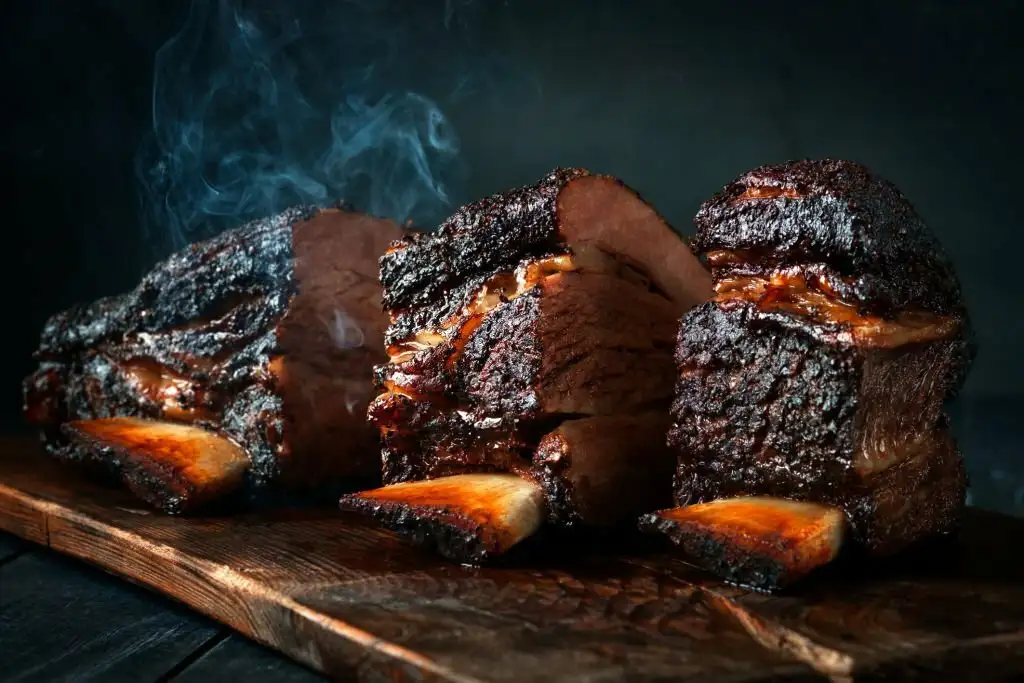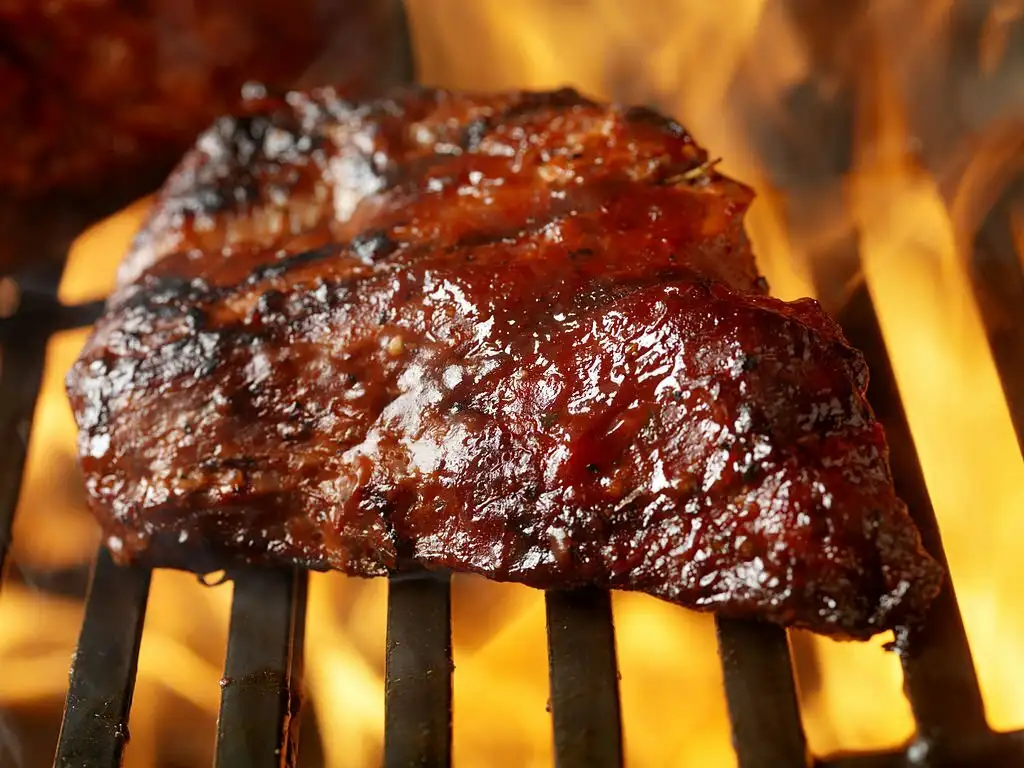A brisket is a cut of meat from the breast or lower chest area. Many people wonder, “is brisket beef or pork?” To clarify, brisket is always beef, never pork.
The brisket cut includes the pectoral muscles of the cow, which get a lot of exercise as the animal moves around, which gives the brisket an inherently tough & fibrous texture.
When cooked low and slow, as is tradition, the collagen in brisket breaks down into gelatin, which tenderizes the meat.
Table of Contents
Types of Brisket Cuts
There are three main types of brisket cuts:
Flat Cut Brisket
The flat cut comes from the brisket’s leaner bottom half. It’s a long, rectangular piece of meat that the point cut.
The flat cut or “first slice” is often served because it looks prettier with an even shape and smoke ring when you slice a smoked brisket. But it can become dry without enough fat.

Point Cut Brisket
The point cut comes from the upper half of the brisket. It has more marbling and fat interwoven through the meat, which keeps it tender and moist during cooking. Some might wonder, “is brisket beef or pork?” but the answer is that brisket is always beef.
The point cut has a fattier seam of meat running through–It’s less uniform in shape compared to the flat. But the extra flavour and tenderness make it a favourite for many pitmasters.
Packer Cut Brisket
A full-packer brisket includes both the flat and the point connected by a thick layer of fat–The most common brisket cut used for smoking or barbecue. Some might question, “is brisket beef or pork?” To clarify, brisket is strictly beef.
The packer cut allows the fattier point to baste the leaner flat during cooking. It provides the most flexibility when carving the smoked brisket for serving.
Brisket Quality Grades
- Prime: Highest grade with heavy marbling throughout the meat. Around 2% of graded beef achieves Prime status.
- Choice: High quality with slightly less marbling than Prime. Choice brisket has excellent flavour and tenderness.
- Select: Leaner with less marbling. Select brisket must be cooked carefully to prevent dryness.
- Ungraded or Standard: Minimal marbling can still be flavorful if cooked properly.
Lower grades are suitable if cooked over many hours. Look for flexibility in the meat rather than hardness. Avoid brisket that has a lot of surface fat that needs trimming.
How is Brisket Cooked?
Brisket needs long, slow cooking to break the collagen into gelatin, which tenderizes the meat into a succulent, fork-tender barbecue. You can make briskets using methods like:
- Smoking: The traditional way to cook brisket is by slowly infusing smoked flavour over 12-18 hours.
- Braising: Brisket is browned and then covered in a flavorful liquid like broth, wine, or sauce for 2-3 hours.
- Slow Roasting: Roasted uncovered in the oven at around 325°F for up to 5 hours until tender.
- Sous Vide: Vacuum-sealed brisket is submerged in hot water at 155-165°F for 24-48 hours to turn tender.
- Instant Pot: Pressure cooking brisket for 1-2 hours mimics the results of slow braising in a fraction of the time.
Low and slow-cooking brisket, no matter the cooking method, gives the collagen time to break down and the fat to render into the meat.
Regional Brisket Styles
Brisket is nationwide but reigns supreme in Texas barbecue. Many people often ask, “is brisket beef or pork?” In reality, brisket is always beef. Regional styles have developed across the states.
- Texas Style: Liberal use of salt and pepper creates a blackened bark on smoked brisket served without sauce so the natural flavours shine.
- Kansas City Style: A thick, sweet tomato or molasses-based barbecue sauce is slathered during smoking and served on the side.
- Memphis Style: Dry rubbed smoked over indirect heat to finish with a sticky, tangy sauce.
- Jewish Style: Jewish delis serve fork-tender brisket braised in a broth heavily seasoned with onions.
How to Smoke a Brisket?
For authentic smoked brisket:
- Select at least a 12-pound packer brisket with marbling. Inject with beef broth for extra moisture.
- Prepare a rub using spices like salt, pepper, paprika, garlic powder, cumin and brown sugar. Coat the brisket liberally.
- Smoke the brisket fat side up at 225-250°F using indirect heat with a water pan to prevent drying.
- Spritz the brisket every 45 mins with broth, Worcestershire, and apple juice to keep it moist.
- Wrap in butcher paper or foil once it reaches 160°F internal temperature. This powers through the stall.
- Continue cooking until 203-208°F on an instant-read thermometer for maximum tenderness.
- Rest the brisket wrapped for 1-2 hours before slicing against the grain. Retain juices.
- Serve sliced brisket drizzled with meat juices for moistness. Offer barbecue sauce on the side.

How to Serve Brisket?
Beyond traditional barbecue plates, try serving smoked brisket in creative ways:
- Sandwiches: Piled high on soft buns or Texas toast. Add pickles and sauce.
- Baked Potatoes: Turn brisket into luscious pulled meat to top baked potatoes.
- Nachos: Chopped brisket, cheese sauce, and fried tortilla chips.
- Breakfast Tacos: Chop brisket with scrambled eggs and cheese in a tortilla.
- Pizza: Brisket, sauce, and pickled jalapenos give pizza a smoky twist.
- Chili: Use cubed brisket of ground beef for a hearty chilli.
- Salads: Thinly sliced brisket served over fresh greens with vinaigrette.
- Burgers: Add chopped brisket to your favourite burger blend for juiciness.
Brisket is endlessly versatile. From quintessential Texas barbecue to creative dishes, many might ponder, “is brisket beef or pork?” In every case, beef brisket brings rich, smoky flavour and unbelievable tenderness, making it a staple in various cuisines.
For more delicious recipes and cooking tips, especially if you’re looking to experiment with brisket in different cuisines, visit Quick Recipees.


